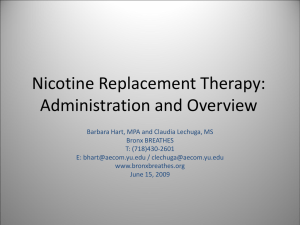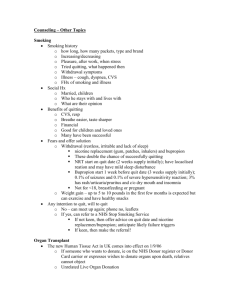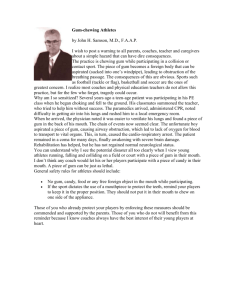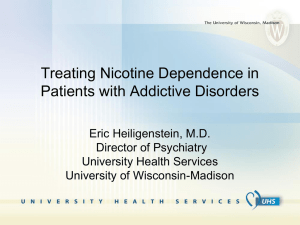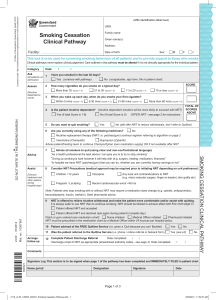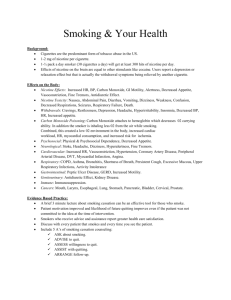Nicotine Replacement Therapy Protocol for Nurses
advertisement
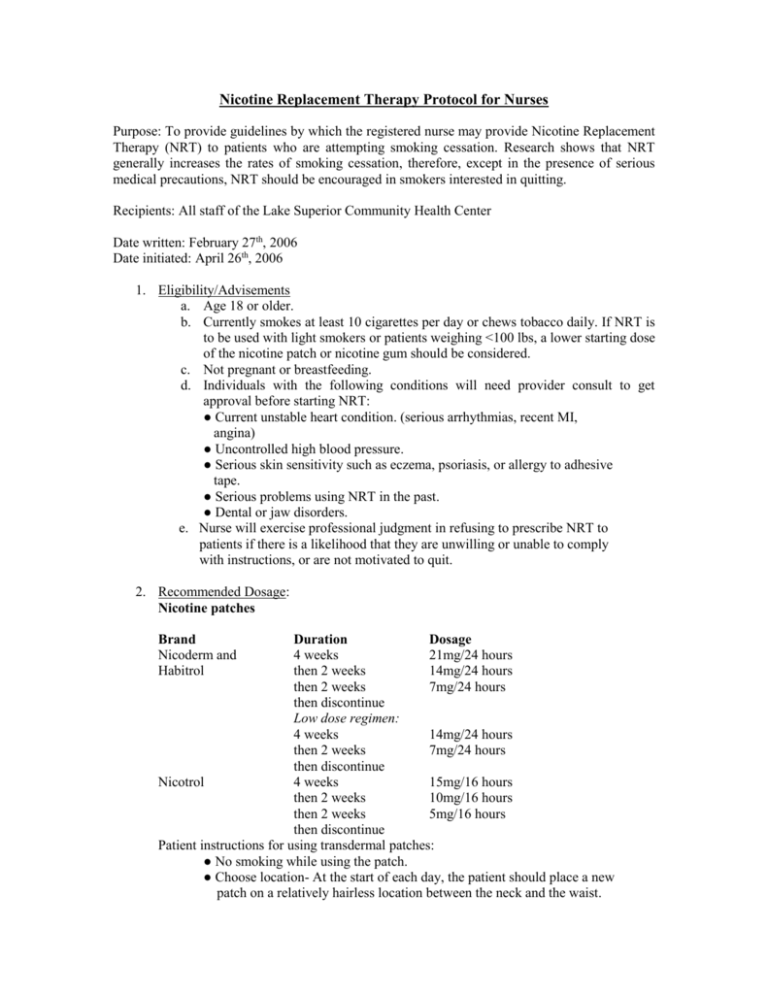
Nicotine Replacement Therapy Protocol for Nurses Purpose: To provide guidelines by which the registered nurse may provide Nicotine Replacement Therapy (NRT) to patients who are attempting smoking cessation. Research shows that NRT generally increases the rates of smoking cessation, therefore, except in the presence of serious medical precautions, NRT should be encouraged in smokers interested in quitting. Recipients: All staff of the Lake Superior Community Health Center Date written: February 27th, 2006 Date initiated: April 26th, 2006 1. Eligibility/Advisements a. Age 18 or older. b. Currently smokes at least 10 cigarettes per day or chews tobacco daily. If NRT is to be used with light smokers or patients weighing <100 lbs, a lower starting dose of the nicotine patch or nicotine gum should be considered. c. Not pregnant or breastfeeding. d. Individuals with the following conditions will need provider consult to get approval before starting NRT: ● Current unstable heart condition. (serious arrhythmias, recent MI, angina) ● Uncontrolled high blood pressure. ● Serious skin sensitivity such as eczema, psoriasis, or allergy to adhesive tape. ● Serious problems using NRT in the past. ● Dental or jaw disorders. e. Nurse will exercise professional judgment in refusing to prescribe NRT to patients if there is a likelihood that they are unwilling or unable to comply with instructions, or are not motivated to quit. 2. Recommended Dosage: Nicotine patches Brand Nicoderm and Habitrol Duration Dosage 4 weeks 21mg/24 hours then 2 weeks 14mg/24 hours then 2 weeks 7mg/24 hours then discontinue Low dose regimen: 4 weeks 14mg/24 hours then 2 weeks 7mg/24 hours then discontinue Nicotrol 4 weeks 15mg/16 hours then 2 weeks 10mg/16 hours then 2 weeks 5mg/16 hours then discontinue Patient instructions for using transdermal patches: ● No smoking while using the patch. ● Choose location- At the start of each day, the patient should place a new patch on a relatively hairless location between the neck and the waist. Remove and discard old patch. ● Patch should be applied as soon as they awaken on their quit day. ● If patient experiencing sleep disturbance, remove patch prior to bedtime or use 16 hour patch. Chewing gum Nicotine gum is available in 2mg and 4mg (per piece) doses. Patients should be prescribed the 2mg gum if smoking less than 25 cigarettes per day, or weigh <100 lbs, while the 4mg is recommended for patients smoking 25 or more cigarettes per day, or if they failed to quit using the 2mg gum. Note the maximum pieces allowed per day. Brand Nicorette (2mg, 4mg) Duration 6 weeks then 3 weeks then 3 weeks then discontinue Dosage 1 piece Q 1-2 hours 1 piece Q 2-4 hours 1 piece Q 4-8 Max- (2mg) 30 pieces/day (4mg) 20 pieces/day Patient instructions for using gum: ● No smoking while using the gum. ● Chewing technique- Gum should be chewed slowly until a “peppery” or minty taste emerges, then “parked” between cheek and gum to facilitate absorption. Gum should be intermittently “chewed and parked” for about 30 minutes or until taste dissipates. ● Absorption- Avoid food and acidic drinks (coffee, juice, soda) for 15 minutes before and during chewing. They may interfere with buccal absorption of nicotine. ● Encourage chewing the gum on a regular schedule as patients often do not use enough gum to get the maximum benefit. ● Side effects could be mouth soreness, hiccups, dyspepsia, and jaw ache. They are usually mild and transient, and often can be alleviated by following the above chewing technique. 3. Other Considerations ● Offer smoking cessation education and quit help materials. ● Offer our counseling services for smoking cessation. ● Offer quit lines for support: Wisconsin Quit Line- 1-877-270-STOP (7867) Minnesota Quit Line- 1-888-354-PLAN (7526) Information taken from: 1. Tobacco Use Prevention and Cessation for Adults and Mature Adolescents. Blue Cross/Blue Shield of MN, 2002 2. Treating Tobacco Use and Dependence A how-to packet for implementing the U.S. Public Health Service Clinical Practice Guideline, 2000 3. Monthly Prescribing Reference. December, 2004 issue Planned review: July 1, 2009 ________________________________ Gail E. Baldwin __________________________ Date

